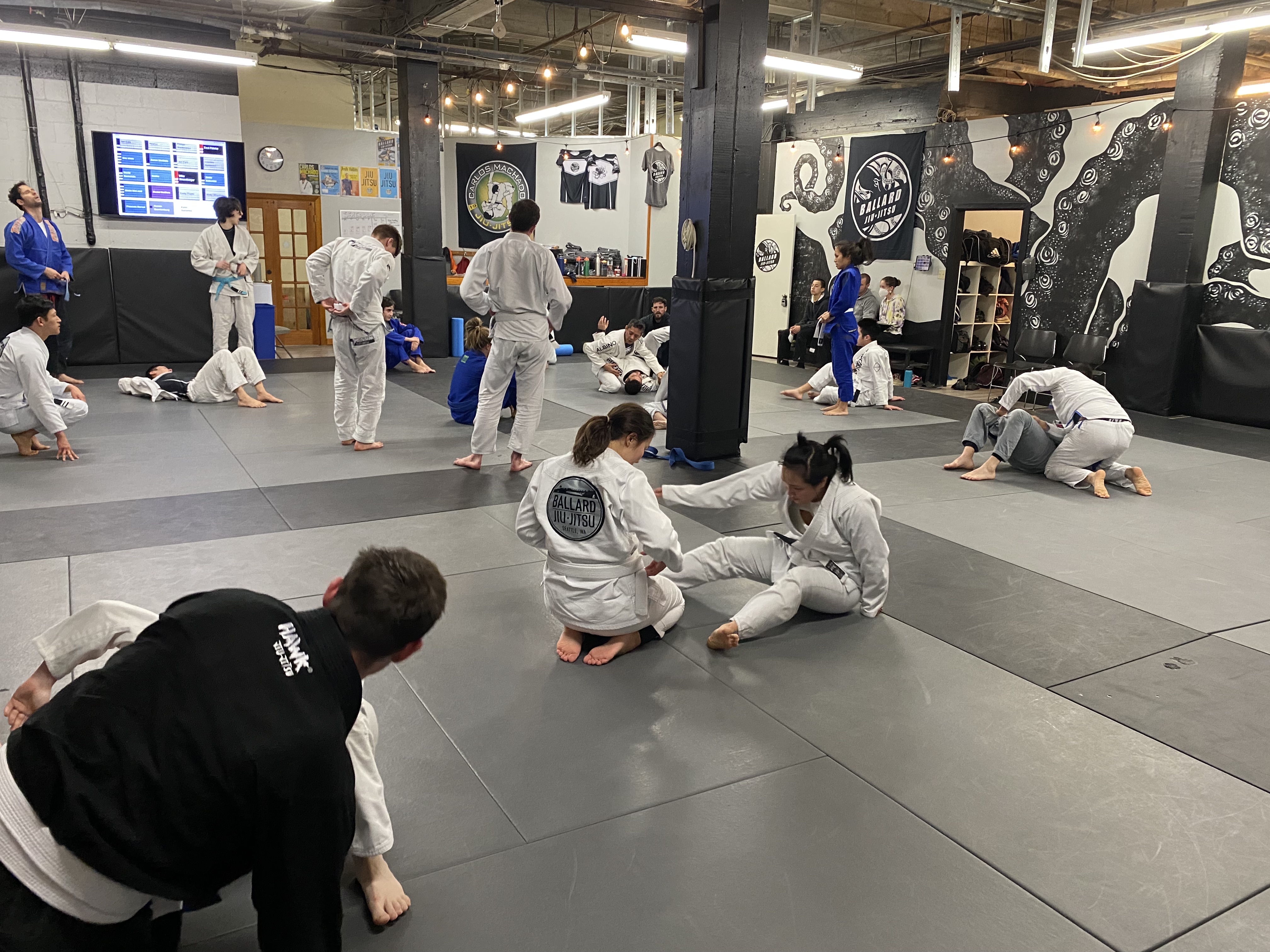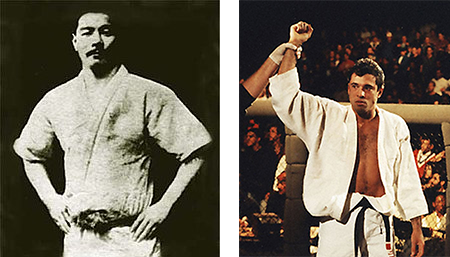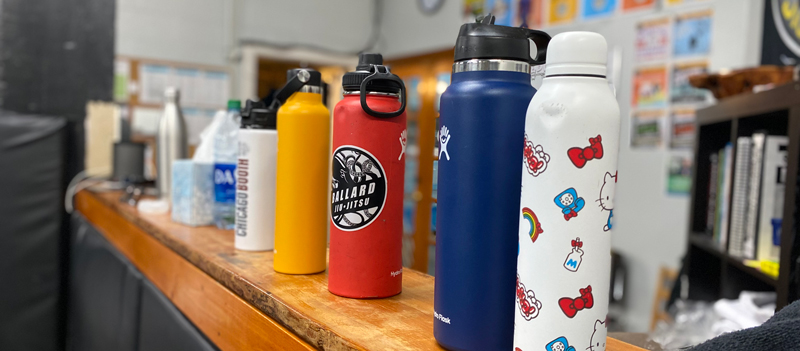
Brief History of Brazilian Jiu Jitsu

Mitsuyo Maeda, left; Royce Gracie in UFC 1, right.
Originally brought from Japan to Brazil by Count Maeda, Brazilian Jiu-Jitsu was developed from a judo base and expanded by the Gracie and Machado families in Brazil. The martial art focused on using leverage and position to subdue an opponent. In 1993, the UFC launched as a showcase for different martial arts and Brazilian Jiu-Jitsu showed its value in the octagon. Since those early days, jiu-jitsu has taken off around the world. Mixed Martial Arts competitions grew and evolved. Jiu-Jitsu tournaments have grown as well. As the evolution of Martial Arts continues, Brazilian Jiu-Jitsu has solidified its place as fundamental martial arts knowledge.
The process of learning Brazilian Jiu Jitsu is a long process. Some folks are encouraged by this because they can actively keep learning for years. A typical black belt takes about 10 years to earn. The belt levels are flat, which is to say there are not many belt levels: White, Blue, Purple, Brown and Black. Working with your training partners over the course of years leads to tremendous learning, excellent exercise and a great sense of community.
The most common set of questions for beginners revolve around three big areas: fitness, hygiene, and equipment.
Fitness Requirements
Brazilian Jiu Jitsu is a highly physical sport that involves a lot of body weight movements. If you have any medical condition that would preclude you from high intensity exercise you should avoid jiu jitsu. The sport is a full body work out which means that the best exercise is a full body set of exercises. Most of the movements begin from the core, so emphasizing core strengthening exercises is a great idea. Additionally, the amount of pressure on your neck and head is different from other activities so it is a good idea to do neck strengthening. For many students, participation in Jiu Jitsu provides an excuse to stay fit and eat healthy.
There is a lot of movement in Jiu Jitsu and this leads to a second area of exercise that we recommend: Flexibility. There is a huge range of flexibility among individuals and inflexible students can still be successful, but it helps to work on opening up the hips and increasing your range of motion.

Hygiene
Hygiene is an important concept when training so closely with others. Hygiene guidelines are posted around the gym. Proper hygiene is a form of respect to your training partners. Even with proper hygiene there is a risk of contracting athlete’s foot, ring worm, staph infections or others. Minimize this risk by caring for yourself and your equipment.
After training, take a shower as soon as possible. We recommend using a soap that contains tea tree oil. If you will not be able to shower for a prolonged period after class, there are several companies that make individual body wipes. Again, we recommend body wipes that contain tea tree oil.
Always wash your gear after each use. Properly cleaned and cared for equipment will avoid the nasty bugs that live on unwashed gear.
Keep your fingernails and toenails trimmed.
Equipment
Keep in mind that all equipment wears out and will have to be replaced periodically. On the plus side, quality bjj equipment properly cared for can be expected to serve you for years.
There are two flavors of class: Gi and No-Gi. The gi is a kimono style robe and pants. For Gi classes you would wear your gi, and under the gi you would wear underwear and a rash-guard (or tight-fitting shirt). Additionally, you would wear your belt. For No-Gi classes, you would typically wear a rash-guard and shorts (or fight pants, spats, tights) but no belt.
Gis (required for Gi Classes):
A Ballard Jiu Jitsu School gi is available to purchase. If you choose to compete you will need to wear a gi that has the school logos. If you purchase a different gi, you can buy patches to add to the gi.
We recommend having at least one gi for every day of the week you train. In other words, if you train twice a week, we recommend having two gis. We strongly recommend following the manufacturer's instructions for cleaning so that your gi lasts as long as possible.
Belts (required for Gi Classes):
Wash your belt. Most students simply throw the belt in the washer, but if you are concerned that may cause additional wear and tear on the belt, purchase a mesh wash bag and place your belt inside the bag before throwing it in the wash. If you happen to lose a stripe or two, tell an instructor and the stripe(s) will be replaced.
Mouth Guards (recommended):
Mouth guards are relatively inexpensive, whereas dental procedures are not. Therefore, we recommend using a mouth guard when training, particularly when sparring.
By far the most comfortable mouth guard I've used was a custom mouth guard purchased from my dentist. It was also the most expensive. Check to see if your dental insurance will cover the cost of a custom mouth guard, but if your budget allows, a custom mouth guard is highly recommended.
Otherwise, there are several manufacturers who will send you a kit that allows you to take your own dental impression which is used to make a custom mouth guard for a modest price. Even more economical are various "boil and bite" mouth guards.
No matter what mouth guard you choose, we recommend regular cleaning following the manufacturer's instructions.
Headgear (optional):
Most students forgo any type of headgear, but if you are considering additional protection of your ears or if you have earrings that aren't easily removed, wrestling headgear is inexpensive and readily available.

Water Bottles (required):
Bring a water bottle. We recommend a bottle that is resistant to breaking when dropped and has a strong, secure lid to prevent spills. We strongly recommend clearly labeling your water bottle. If need a drink of water during class, let the instructor know before leaving the mat.
Flip Flops (optional):
Flip Flops are a handy when leaving the mat to use the bathroom. While Ballard Jiu Jitsu has a few pairs of community flip flops, it's not a bad idea to have your own pair. We recommend buying the least expensive pair you can find and labeling them as we all have the habit of shopping the same sales.